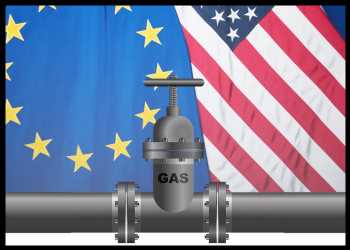The United States will supply 50 billion cubic meters of liquefied natural gas or LNG to Europe this year to make up for shortage in Russian gas supplies, to reduce the European Union’s reliance on Russian energy, and to reduce the EU member states’ overall demand for natural gas.
This has been stated in the annual report published by the joint EU-US Task Force on Energy Security, which presents its accomplishments and outlook for the future.
During 2023, the Task Force will continue to focus on the energy market shocks and high energy prices caused by Russia’s aggression against Ukraine, says a joint statement issued by the White House and the European Commission ahead of an EU-US Energy Council Ministerial Meeting, scheduled for Tuesday.
A year after its establishment, the Task Force has made major progress in meeting its goals to reduce the European Union’s reliance on Russian energy, but EU countries are still scrambling to source sufficient LNG supplies to replace Russian gas.
Task Force priorities for 2023 will include continuous assessments of LNG markets and ensuring U.S. LNG deliveries to Europe of 50 bcm in 2023, reduction of methane emissions, and energy savings and efficiency measures.
In the coming months, the Task Force will continue to work on keeping a high level of U.S. LNG supplies to Europe of at least 50 bcm. This is necessary given the challenging supply situation and the need to ensure storage filling for the next winter 2023-24.
The EU Energy Platform will launch its first joint tenders under the Aggregate EU, a new means of demand aggregation and joint purchasing, in May 2023. Such tenders will be open to all non-Russian gas sellers. The Task Force has facilitated engagement with the U.S. LNG industry on the EU Energy Platform and its upcoming implementation to attract U.S. LNG to Europe.
Further, the Task Force will help implement U.S. and EU efforts to reduce methane emissions, both in bilateral trade and at the global level.
Recognizing the importance of energy efficiency and demand flexibility as key contributors to enhancing energy security, the United States and the European Commission are preparing a series of further sub-dialogues in the energy savings work stream.
According to the report, the United States more than doubled its target to ensure delivery of an additional 15 bcm of LNG to the EU. Last year, U.S. exports to the EU were 56 bcm, up from 22 bcm in 2021. The EU was the largest destination for U.S. LNG exports, accounting for more than 52 percent of supplies. At the end of 2022, Russian gas accounted for only 16 percent of the EU’s gas imports, down from 37 percent in March 2022.
Between August 2022 and January 2023, the EU reduced its overall demand of natural gas by 19 percent, including by lowering electricity use, improving energy efficiency in the residential sector, identifying new digital solutions to help consumers save money, and completing other demand-side measures.
Source: Read Full Article
-
Change Of Guard At Banks, LIC In 2023
-
Alec Baldwin Thanks His Wife & His Lawyer After ‘Rust’ Charges Are Dropped
-
Sundance Institute Layoffs Hit 6% Of Workforce Across All Departments
-
SAG-AFTRA Board Overwhelmingly Approves Deal With AMPTP That Sharply Limits Exclusivity In TV Actors’ Personal Service Agreements
-
The Price Of Eggs Is Soaring

